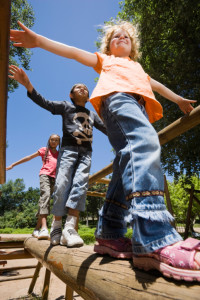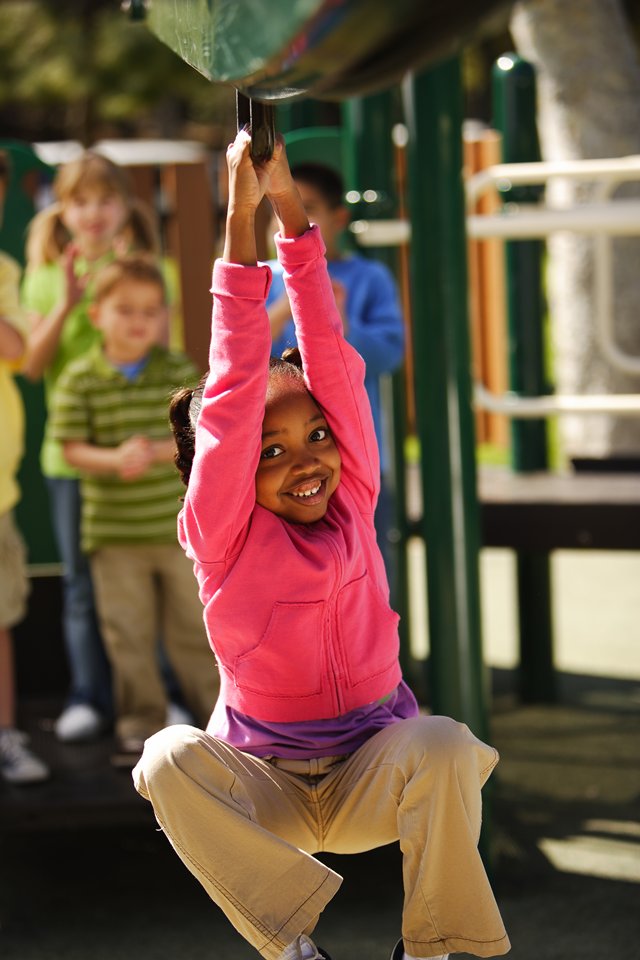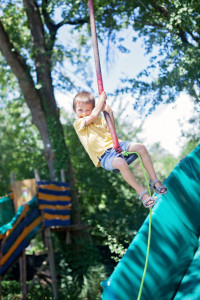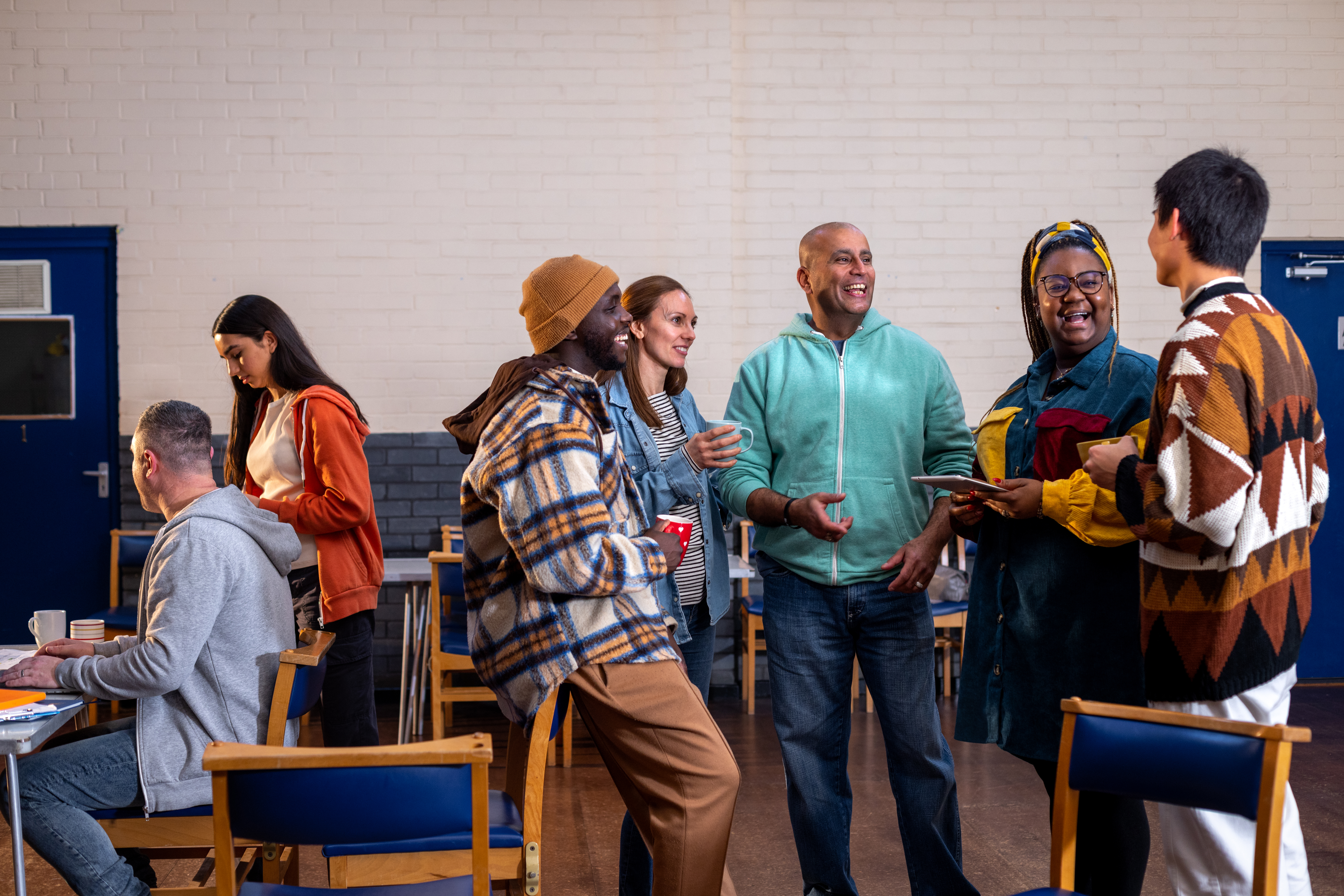Back in the 1970s, landscape architect M. Paul Friedberg famously stated: “Playgrounds are built for insurance companies, not kids.” In today’s media climate it might be more appropriate to say “playgrounds are built for parents, not kids.”
Throughout modern history, child development researchers have explored the merits of raising kids according to the “school of hard knocks” versus a hyper-vigilant “bubble-wrapped kid” approach, and all points in between. The popular view in late 2015 seems to be parenting has swung too much to the protective side.
Where playgrounds are concerned, Friedberg advocated the benefits of the riskier end of the spectrum. While there have been exceptions, however, his proclamation 40 years ago has played out. Urban and suburban playgrounds in the U.S., where most of our kids live and play, emphasize injury mitigation over challenge.
Merry-go-rounds, see-saws, and high swings have all but vanished. We’ve replaced natural materials — wood, sand, bark – with immobile, indestructible plastic, steel, and rubber. Slides and swings are flatter, shorter, and lower.
It’s understandable. According to the Centers for Disease Control, 200,000 kids a year visit emergency rooms after getting hurt at playgrounds. The vast majority of injuries are relatively minor — fractures, lacerations, concussions. (Deaths are rare. Between 2001 and 2009, the Consumer Product Safety Commission investigated 40 deaths attributed to playground equipment.)
Injuries, coupled with a legal system in which judges and juries award hundreds of millions of dollars in damages every year — real and punitive — those are the realities in which public school officials and municipal parks and recreation planners operate in the U.S.
As parents, we want our kids to fulfill their potential, safely. (Although how do you explain skate parks?) Higher heights, loose objects, moving parts, sand, dirt, and uneven surfaces all tend to make parents fret. But do they help children learn and grow? Do kids who have access to riskier play spaces get hurt more often or more severely? Are we doing our kids a disservice emphasizing safety over challenge?
If playgrounds are laboratories where our choices lead to varying outcomes in children’s development and safety, where’s the balance?
Rewards of risk-taking
Dialogue on playground design has been going on for decades. And while the larger trend in the U.S. has been toward durability and safety, all along there’s been an undercurrent advocating challenge and greater risk-taking opportunities, particularly in Europe, where laws limit liability.
“Adventure playgrounds,”the brainchild of renowned landscape architect Carl Theodore Sorenson, became popular in post-World War II Denmark. Marjory Gill, later Lady Allen of Hurtwood, brought Sorenson’s philosophy to English playgrounds.
In these spaces, also referred as “junk playgrounds,” loose materials, and in some, tools, are available for kids to build with, creating opportunity to shape their environments. Parents are politely told to take a hike. The few adults supervising are decidedly hands off, except when providing, hammers, saws, matches, and combustibles. You read that correctly. Playing with fire! Encouraged!
Sorenson and Lady Allen believed these spaces fueled kids’ imaginations and self-confidence. In some respects these sanctioned play spaces evolved organically, as urban kids in postwar Europe had ample options to entertain themselves, unsupervised, amid the ruins of bombed-out buildings.
 Fast forward a couple decades to Friedberg’s books, Play and Interplay, and Handcrafted Playgrounds. In them, the author advocates for play environments here in the U.S. that challenge kids to be creative, use tools, cooperate, make decisions, assess risks, push boundaries.
Fast forward a couple decades to Friedberg’s books, Play and Interplay, and Handcrafted Playgrounds. In them, the author advocates for play environments here in the U.S. that challenge kids to be creative, use tools, cooperate, make decisions, assess risks, push boundaries.
Natural playgrounds renaissance
Inspired by Friedberg and Sorenson, the city of Huntington Beach, California created an adventure playground in 1974. Five years later, Berkeley, California, did likewise. More than four decades later, both are still going strong. Similar parks built around that time — Mountain Park in Houston was one example — have mostly vanished.
In Oregon, landscape designers have created the Oregon Natural Play Initiative. This effort promotes constructing playgrounds that “represent the larger wild environment in a way that feels safe and manageable to young visitors and their parents while inviting imaginative and explorative play.”
Several parks throughout the state have applied principles of natural play, Some are new projects, others renovations of existing playgrounds.
Since voters approved a bond initiative in 2008 to fund improvements, San Francisco parks and recreation planners have introduced riskier elements to playgrounds – higher heights, uneven surfaces, rough textures. So far, no fire.
Berlin is renowned for its scruffy-looking, natural playgrounds, the antithesis of structures we’ve built here. Many Berlin playgrounds incorporate water pumps and channels with rocks available for dam-building, wood, sand, dirt, thorny plants, trees, rocks, rope, and loose materials kids can move and shape. Many include hiding places away from the prying eyes of grownups.
Do kids get hurt more often at playgrounds containing these features?
Research suggests otherwise. A German study, in fact, cited behavior as a far bigger contributing factor to injury than equipment. The conclusion: stimulated, engaged kids are less likely to get bored and misbehave, therefore injuries decrease.
What do kids think?
If playgrounds are too tame, kids notice. Last year, Swedish researcher Märit Jansson interviewed 141 kids ages 6 to 11 in two small Swedish towns. Her intent setting out was to find out what playgrounds these kids frequented most and what they liked to do at them. Unprompted, kids complained about “boring” playgrounds that lacked challenges and didn’t offer opportunities for them to be creative.
Jansson reported kids liked playgrounds that let them be what she called “self-appointed sub-contractors” fetching rocks and moving logs and water to shape their environments.
No one, perfect answer
Clearly, safety must be factored when designing or renovating playgrounds. But have we confused risks with hazards? Risk is a tall structure on which a child can decide how high to go, how many challenges she can handle. A hazard is an improperly anchored apparatus that comes loose through normal use.
Many experts say risk assessment is critical to kids’ development.
Norwegian researcher Ellen Hansen Sandseter asserts children flourish when given opportunities to make decisions, cooperate, explore and push limits when given license and material to shape their play spaces as they wish. Children without these opportunities are more likely to become anxious and fearful.
It’s worth asking whether the benefits outweigh the occasional broken wrists, scraped knees, bloody chins and forehead bumps. The phrase “Better a broken arm than a broken spirit,” crops up frequently in articles on the topic.
Most parents can say we’ve been part of conversations about how things have changed since we were kids. We remark on how much more protective we are of our kids than our parents were of us, how structured our kids’ lives are these days. Often the conversations end with the lament: “Things are just different today.”
In response, popular research lately seems to lean in the direction of giving kids more leeway to learn by doing. That’s easy to accept in the abstract. It’s a lot harder when it’s your kid who’s about to leap off the top rung of the jungle gym.



